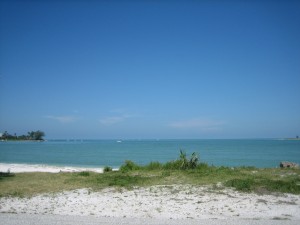 The best way to catch some really great hard-charging snook along the wide open beaches of Southwest Florida, from Tampa down to Boca Grande, is to use the ever-present sand flea. You can locate sand fleas all along the SW Florida beaches and with a sand flea rake or long-handled rake, an angler can have a day’s worth of fine baits within a relatively short period of time.
The best way to catch some really great hard-charging snook along the wide open beaches of Southwest Florida, from Tampa down to Boca Grande, is to use the ever-present sand flea. You can locate sand fleas all along the SW Florida beaches and with a sand flea rake or long-handled rake, an angler can have a day’s worth of fine baits within a relatively short period of time.
The Sand Flea and Big Time Surf Snook Action
Snook in the surf glide across the shallow areas of the beach much like ghostly figures. They are either alone or a couple, and sometimes in what can be referred to as a school of a half-dozen or even more. Most Southwest Florida snook fishermen take along a small pale in order to house the sand fleas that are raked out of the sandy areas.
Snook Swim Close in Along the Beach
The snook of this southern region of the Sunshine State will swim close in along the beach following a very straight and narrow course westward along the oceanic Gulf of Mexico current. As long as the snook fisherman causes very little commotion along the beach, these giant snook will be less-apt to spook. Snook can either be sighted cruising along the shoreline or when one breaks free from the school to smash a ball of bait fish. Either way the snook of South West Florida love to patrol up and down the beach in this beautiful southern location.
Beaches are Pristine
Sanibel Island Fla, an island off the coast of Fort Myers in Southwest Florida, is a sight for sore eyes. The beaches are as pristine as when the first Spanish explorers encountered this magnificent environmental treasure. The marshlands that are picture-postcard perfect, identify this location as a thing of wonder and beauty. Depending upon the spawning and migratory season of the snook, it is best to match the area fished in Southwest Florida with the time of year.
Perpetually-Hungry yet Wily-Veterans of the Gulf Coast
A great way to hook up with one of these perpetually-hungry yet wily-veterans of the Gulf Coast area is to use the above mentioned sand flea- live bait method. Understanding that there will be less snag opportunities and more room for the snook to make their fantastic long-winded runs and hopefully, a few spectacular jumps. The beach is the spot for great snook fishing.
Use Lighter-Line Surf Fishing
Right off the bat the snook surf angler uses a lighter-line since there is less chance of breakage from obscured and hidden structures. Combined with a few football-field lengths in which to run uncharted; a lighter-line is the choice of the day. 8 to 12 pound test line will be sufficient and this of course will need a heavy duty yet non-wire leader. The mouth is not the area of concern for cutting through, even a 60 pound test leader, it is the razor-sharp gill coverings that are responsible for most cut-offs. Even though it’s tempting to swivel-snap on a piano wire leader or some other material, it is not advisable as this is not croaker fishing on the bottom of the Atlantic Ocean!
6 to 7 foot Medium-Action Rod
A longer rod, graphite-composite, 6 to 7 foot medium-action are preferred for most snook anglers when choosing surf fishing rods. While surf fishing for snook, it is important that you attempt to make the entire fishing gear invisible to the seemingly intelligent and wily snook. Keep the line light and the pole long and sensitive. Rig up the live sand flea as you would a live crab, paying close attention not to spear internal organs and utilize the hard shell covering. Cast 15 to 25 feet ahead against the current allowing your bait to come back to the snook in a natural manner. All that’s left is to do is hang on and have the time of your life fishing in the surf for Southwest Florida snook!
Get Your Guaranteed Course on
How To Catch Snook Today !